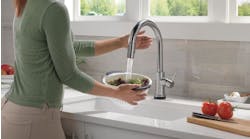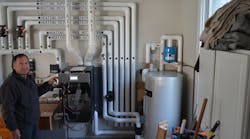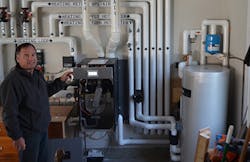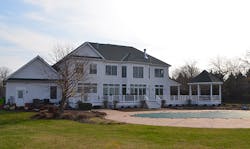Latest from Hydronics Systems
Sponsored
Hydronic system delivers comfort, efficiency
STEVENSVILLE, MD. — There are quite a few perks to having a backyard that ends in the Chesapeake Bay. The fishing can be great, the views are wonderful, and the fresh salty breeze is unbeatable in the summer. But in the winter, that pleasant breeze turns wild, howling across open water and onto land.
While Stevensville, Maryland, enjoys a climate with fewer heating degree days than much of hydronic country, the wind off the bay is enough to turn the tides in favor of a hot water system. Wilfre Company Inc. was referred to the owner of a 4,500-sq.ft., bayside home whose existing heating system wasn’t sufficient when the wind kicked up.
Air-to-air heat pumps were the primary source of heat, with hydro-air coils and a large condensing boiler as a second stage.
“The boiler was programmed to take over at 30°F,” said Martin Harrison, owner of Wilfre Co., in Hebron, Maryland. “The main problem, though, is that the original near-boiler piping wasn’t up to snuff. The home couldn’t get near enough flow to satisfy the thermostat.”
Because the project involved airside equipment, ductwork, controls and hydronics, Wilfre’s do-it-all approach made them the perfect outfit for the job. The full-service company, with 30 trucks on the road, even has its own sheet metal shop.
“My father and uncle started the company in 1970 as a backhoe rental, got into plumbing two years later, and opened a mechanical division six years after that,” explained Harrison. “Fifteen years ago, my brother, Bill and I took over, and the rest is history.”
Just a few pumps short
When Harrison arrived at the seaside home last fall, a 250 MBH condensing boiler was supplying hot water to two air handlers — one upstairs and one downstairs. The hydronic coils in the ductwork couldn’t get adequate flow.
Amidst the spaghetti bowl of near-boiler piping, there were only two circulators on the whole system. One pump served the indirect water heater, while the other, located on the return side of the boiler, was attempting to provide all other circulation. There were no zone valves.
Wilfre technicians completed a Manual J, coming in at 180,000 BTUh with a 10°F outdoor design temp. This confirmed what they already suspected: the boiler was big enough, and then some.
“I suggested replacing the 12-year-old boiler with a new condensing boiler and re-piping the entire mechanical room,” said Harrison. “At first, the homeowners didn’t want another hydronic system. Understandably, the old system left a bad taste in their mouths. But they came around after seeing the numbers and learning that the incorrect near-boiler piping was the problem, and that hydronic systems are generally accepted as the premium heating option.”
Clean slate
Wilfre disassembled the existing system in September, when the heat pumps would have no trouble satisfying any call for heat. The new 210 MBH Burnham Alpine condensing boiler was hung on the wall, along with a US Boiler Sage Zone Control and a Grundfos ECM circulator for each of the two zones.
“We built a primary/secondary system so that the zones operate independently of each other now,” said Harrison. “The Alpine installed easily, and even field-converted from natural gas to LP without swapping orifice plates.”
Shortly before the project started, Steve Kidwell, at rep firm ROI Marketing, had introduced Harrison to the Alpine line. The first experience Wilfre had with the boilers was during construction of ROI’s live-fire, mobile training lab. After installing them in the trailer, Harrison wanted to put one in the field. Since the bayside home needed a large capacity, the Alpine was a perfect fit. With eight models between 80 and 800 MBH, the high-efficiency Alpine fits nearly any residential and light commercial application.
“The only challenge on this project was keeping ample domestic hot water available while the system was down,” said Harrison. “The master bedroom has an 80 gallon tub that gets used almost daily.”
To keep DHW flowing, they put in a temporary 50-gal. electric tank. Once the new boiler was up and running, the existing 60-gallon tank was left in service. With the Alpine’s big capacity and the water heater set to priority, there hasn’t been any trouble getting enough hot water to the bathtub.
Satisfied, to say the least
Despite the somewhat common misconception that condensing boilers don’t work well with hydro-air coils, the system delivers comfort and efficiency.
“A lot of installers think that you need to run 170°F or 180°F water through a coil to make hot air,” said Harrison. “That’s just not the case at. Much lower water temperatures can be used, depending on the home, which makes it a lot easier for the boiler to operate inside of condensing conditions. But it is extremely important to set the supply water temperature based on the load, and to have the outdoor reset control properly programmed.”
Throughout the project, the homeowner noticed the quality of work that Wilfre was providing. The front of the garage was no longer occupied by a massive copper octopus. Instead, a wall-hung boiler is now joined by new circulators, clearly marked piping, and a well-insulated primary/secondary system.
“When the temperature really falls, there’s absolutely no comparison,” said the homeowner. “This system is far more comfortable, and the boiler is quieter than the old one.”
While the family didn’t keep track of their propane use, they have commented that the boiler runs far less often, and longer per cycle. That alone proves that the system operates as intended.
“We’re glad we hired Wilfre for the job,” the homeowner continued. “They do phenomenal work.”




